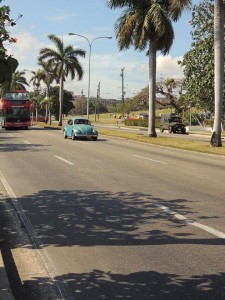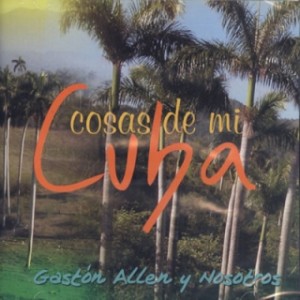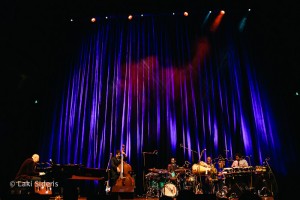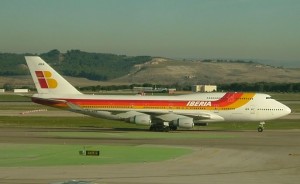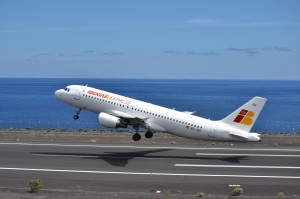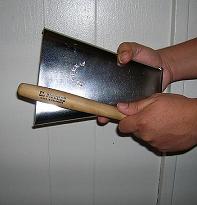 The “Centerro” is a small, rough, usually cylindrical and made of copper or iron plate. In northern Spain, particularly in Cantabria, is a bell hanging from the neck of the cows, whose mouth is usually narrower than the handle, and have the clapper horn.
The “Centerro” is a small, rough, usually cylindrical and made of copper or iron plate. In northern Spain, particularly in Cantabria, is a bell hanging from the neck of the cows, whose mouth is usually narrower than the handle, and have the clapper horn.
This ‘cencerro’ is used as a percussion instrument IN Cuba and other countries. Modern small bells or bells without clappers are made specific for use as-musical instruments can be fixed to a support and are idiófonos shaken.
Are struck with wooden drumsticks specially designed for this instrument. Normally, they are made of copper, steel or alloy steel. They are used for many different sizes depending on the style of music that is used sounds. Whatever size the resulting sound is indeterminate.
You can get four general sounds:
Open sound sharp.
Closed sharp sound.
Open bass sound.
Sound severe closed.
To get the sounds closed to do some pressure on the instrument with the index and middle fingers. Instead of producing sounds no open press the instrument.
The bass sound is practiced percutiendo the instrument with the stick at the widest part of the bell. The sharp sound is produced by hitting the stick in the narrowest part.
You can also get two sound effects:
The rebound effect: is to touch any of the above sounds letting the stick bounce.
The effect of roll: the stick is achieved by introducing into the bell and moving so that hit the walls of the instrument.
The bells have a prominent role in the music of Latin American dance, where they are used, and when included in the orchestra are grouped in Subsection small percussion.
In Cuban music, the person who plays the bongos, often alternating the two instruments, so called bongocerro. In this sense, many times, the cowbell is also placed on the lectern and timbales, both instruments are also combined.
Agencies/Various/internetPhotos/www.thecubanhistory.com
The Cuban History, Hollywood.
Arnoldo Varona, Editor.
 INSTRUMENTOS MUSICALES CUBANOS: EL CENCERRO.
INSTRUMENTOS MUSICALES CUBANOS: EL CENCERRO.
El cencerro es una campana pequeña y tosca, generalmente cilíndrica y hecha con chapa de cobre o hierro que se cuelga del cuello de las reses.
El cencerro es usado en Cuba y otros paises también como instrumento musical de percusión. Modernamente se fabrican pequeñas campanas o cencerros sin badajo específicos para ser usados como instrumentos musicales- Pueden estar fijos a un soporte y son idiófonos sacudidos. Se percuten con baquetas de madera especialmente diseñadas para este instrumento. Normalmente, se fabrican en cobre, acero o en aleación de acero. Se utilizan de distintos tamaños para conseguir diversos sonidos dependiendo del estilo de música en el que sea utilizado. Sea cual sea su tamaño el sonido resultante es indeterminado.
Se pueden conseguir cuatro sonidos generales:
Sonido agudo abierto.
Sonido agudo cerrado.
Sonido grave abierto.
Sonido grave cerrado.
Para conseguir los sonidos cerrados hay que hacer cierta presión sobre el instrumento con los dedos índice y corazón. En cambio para producir los sonidos abiertos no hay que presionar el instrumento.
El sonido grave se practica percutiendo el instrumento con la baqueta en la parte más ancha del cencerro. El sonido agudo se consigue golpeando la baqueta en la parte más estrecha.
También se pueden conseguir dos efectos de sonido:
El efecto de rebote: consiste en tocar cualquiera de los sonidos anteriores dejando rebotar la baqueta.
El efecto de redoble: se consigue introduciendo la baqueta en el interior del cencerro y moviéndola de forma que golpee con las paredes del instrumento.
Los cencerros tiene un papel destacados en la música de baile latinoamericana, donde son muy utilizados, y cuando se incluyen en la orquesta están agrupados en el subapartado de pequeña percusión.
En la música cubana, la persona que toca los bongos, a menudo, alterna los dos instrumentos, por eso se llama bongocerro. En este sentido, muchas veces, el cencerro también se coloca en el atril de los timbales y, también se combinan ambos instrumentos.
Agencies/Various/internetPhotos/www.thecubanhistory.com
The Cuban History, Hollywood.
Arnoldo Varona, Editor.



![ROBERTO_ROENA_7[1]](https://www.thecubanhistory.com/wp-content/uploads/2014/09/ROBERTO_ROENA_71-198x300.jpg)
